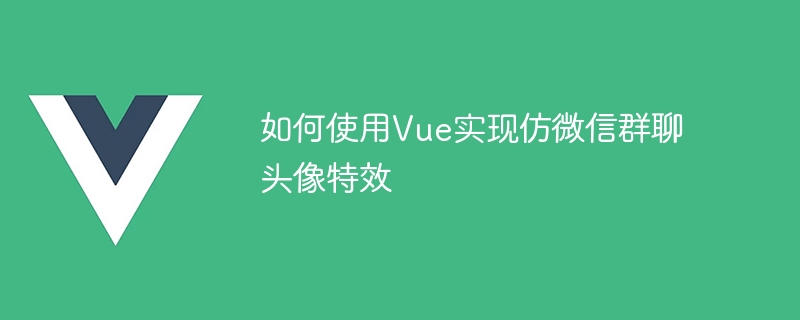Home >Web Front-end >Vue.js >How to use Vue to implement imitation WeChat group chat avatar effects
How to use Vue to implement imitation WeChat group chat avatar effects
- WBOYWBOYWBOYWBOYWBOYWBOYWBOYWBOYWBOYWBOYWBOYWBOYWBOriginal
- 2023-09-19 10:18:381836browse

How to use Vue to implement imitation WeChat group chat avatar effects
With the development of social media, we often see various interesting special effects in various applications. Among them, the imitation WeChat group chat avatar effect is a very popular effect. In this article, we will teach you how to use the Vue framework to achieve this effect and provide some specific code examples.
Before we start, we need to prepare the development environment. Make sure you have Node.js and Vue CLI installed. If it is not installed, you can install it with the following command:
npm install -g vue-cli
Next, we create a new Vue project:
vue create wechat-avatar-effect
Enter the project folder and run the project:
cd wechat-avatar-effect npm run serve
Now we are ready to start coding.
First, we need to introduce the required style sheets and images. Create a new folder in the src/assets directory, name it css, and create a new file styles.css in it. Add the following code to styles.css:
.avatar-effect {
position: relative;
display: inline-flex;
align-items: center;
justify-content: center;
width: 48px;
height: 48px;
border-radius: 50%;
background-repeat: no-repeat;
background-size: cover;
}
.avatar-effect:before {
content: "";
position: absolute;
top: 0;
left: 0;
display: block;
width: 100%;
height: 100%;
border-radius: 50%;
background-color: rgba(0, 0, 0, 0.5);
opacity: 0;
}
.avatar-effect:hover:before {
opacity: 1;
}
.group-count {
position: absolute;
top: 50%;
left: 50%;
transform: translate(-50%, -50%);
color: #fff;
font-size: 12px;
}Create a new folder in the src/assets directory, name it images, and drag and drop the picture file of the WeChat group chat avatar into the folder.
Next, we will create a new Vue component Avatar.vue. Create a new file Avatar.vue in the src/components directory and add the following code:
<template>
<div class="avatar-effect" :style="avatarStyle">
<img :src="require('@/assets/images/' + image)" alt="avatar">
<span class="group-count" v-if="showCount">{{ count }}</span>
</div>
</template>
<script>
export default {
props: {
image: {
type: String,
required: true
},
count: {
type: Number,
default: 0
},
showCount: {
type: Boolean,
default: true
}
},
computed: {
avatarStyle() {
return `background-image: url(${require('@/assets/images/' + this.image)})`;
}
}
};
</script>
<style scoped>
@import '@/assets/css/styles.css';
</style>In the above code, we created an Avatar component and defined three properties: image, count and showCount. The image attribute is a required attribute, used to specify the file name of the avatar picture; the count attribute is optional, used to specify the number of people in the avatar; the showCount attribute is optional, used to control whether to display the number of people. The computed attribute avatarStyle is used to dynamically calculate the background image style of the avatar.
Next, we will use the Avatar component to implement WeChat group chat avatar effects. Add the following code to src/App.vue:
<template>
<div id="app">
<h1>WeChat Avatar Effect</h1>
<div class="avatar-container">
<Avatar v-for="(avatar, index) in avatars" :key="index" :image="avatar.image" :count="avatar.count" :showCount="true" />
</div>
</div>
</template>
<script>
import Avatar from "./components/Avatar.vue";
export default {
name: "App",
components: {
Avatar
},
data() {
return {
avatars: [
{
image: "avatar1.jpg",
count: 10
},
{
image: "avatar2.jpg",
count: 5
},
{
image: "avatar3.jpg",
count: 0
}
]
};
}
};
</script>
<style>
.avatar-container {
display: flex;
justify-content: center;
align-items: center;
margin-top: 20px;
}
</style>In the above code, we introduced the Avatar component in the App component and used the v-for directive to loop through rendering a set of avatars. The avatars array is simulated avatar data, which contains the picture and number of people for each avatar.
Run the project and you will see a page that imitates WeChat group chat avatar effects, including multiple avatars and the corresponding number of people.
So far, we have successfully used Vue to implement WeChat group chat avatar effects. Through code examples, we learned how to create an Avatar component and pass data using props attributes. In addition, we also used CSS styles to achieve special effects.
I hope this article is helpful to you, thank you for reading!
The above is the detailed content of How to use Vue to implement imitation WeChat group chat avatar effects. For more information, please follow other related articles on the PHP Chinese website!

